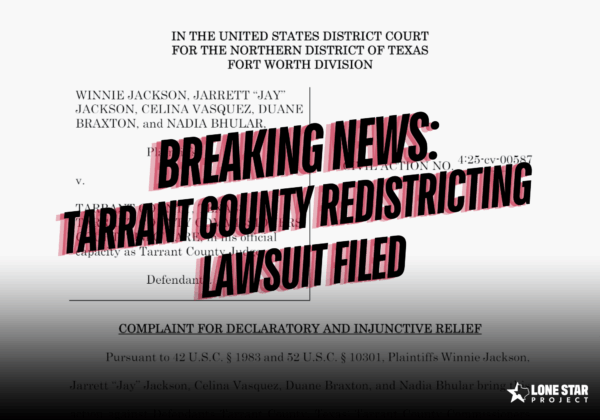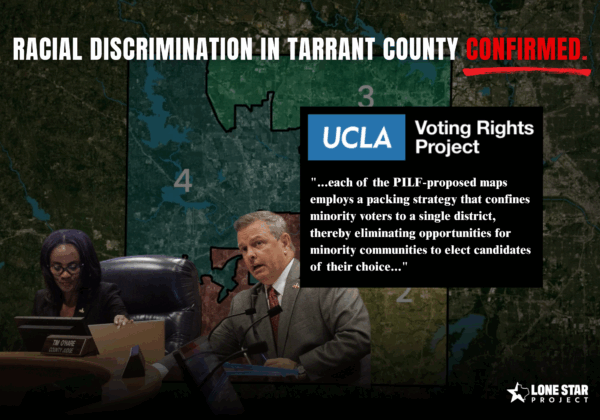Much of the media bought into the flawed and simplistic GOP characterizations of SD10 during the 2012 election cycle only to see Wendy Davis mobilize a diverse coalition of Democrats, Independents and fair-minded Republicans to win re-election by over 6,000 votes.
Lone Star Project analysis of SD10 proven correct
The Lone Star Project has analyzed elections, demographic trends and polling in SD10 since 2006. In early 2007, we characterized SD10 as a swing district that could be captured by an adequately funded centrist Democrat. Wendy Davis’ defeat of long-time incumbent Kim Brimer in 2008 confirmed our analysis. In 2012, again contrary to repeated statements by Republican operatives and gullible reporters, the Lone Star Project accurately predicted that a flawed GOP candidate combined with improving demographics for Democrats in SD10 and a strong, well-run campaign by Davis would result in her re-election. Our predicted scenario played out precisely. Davis won by building and mobilizing a politically and racially diverse coalition of mainstream voters.
Wendy Davis is tough, tested and admired
All of the dynamics that resulted in Wendy Davis’ victories in 2008 and in 2012 remain in place. In terms of skill, experience and overall appeal, Davis is simply a better candidate and public official than any local Republican option.
- Wendy Davis has a compelling personal history having been raised by a single mother, married young and later became a single mother herself. She went from raising her daughters in a small trailer to working her way through college – from enrolling in community college to transfering and graduating from TCU and finally earning a law degree from Harvard.
- Davis has proven her abilities as a candidate, having defeated a long-time entrenched Republican incumbent in 2008. When Davis first announced her candidacy for the State Senate, reporters and statewide pundits just assumed she would lose. Only local minority leaders, the Lone Star Project and some local activists understood the underlying Democratic strength of the district and Wendy Davis’ strengths as a candidate. Davis proved to be an outstanding candidate and built a top-notch and winning campaign organization.
- Davis has charted a mainstream, centrist legislative course while having the courage to stand up to Governor Perry and other state leaders when they are wrong. Most notably, she led a filibuster that highlighted the Republican budget that removed billions from Texas public schools while protecting lobby concerns important to Governor Perry and other statewide Republicans.
- Davis took the Republican’s best shot in 2012 and emerged strongerthan ever. Davis was the top Republican target in 2012. Rick Perry and nearly every statewide Republican endorsed and campaigned for her opponent, who was fully funded by Republican powers in Texas. Davis built a better campaign, a broader coalition and worked smarter and harder than the Republicans, winning re-election by an even greater margin than in 2008.
- Davis’ courage and energy excite and mobilize supporters. Even well-liked politicians have a hard time keeping their supporters active and excited. Davis quickly creates a personal bond with supporters who rally to her defense when she is challenged. A current online petition calling on Lt. Governor Dewhurst to reappoint Davis to the Public Education Committee after he removed her already has over 3,000 signatures.
Wendy Davis is, the likely winner in 2014 – unless, of course, she runs for statewide office. And, given statewide demographic trends and Wendy Davis’ qualifications and skills as a mainstream Democratic candidate, this scenario could prove to be an even greater problem for Texas Republicans.
Off-year election results in SD10 show underlying Democratic strength
Despite there being no active or adequately funded local or statewide Democratic campaign within SD10 in 2006 or in 2010, key down-ballot candidates performed relatively well.
2006
The statewide Democratic ticket in 2006 was unfunded, and none of the Democratic statewide candidates had active political operations in SD10. Despite this lack of Democratic political activity, Tarrant County Democratic District Attorney candidate Terri Moore received 49.4 percent of the vote in SD10 and State Supreme Court Candidate Bill Moody received 47 percent of the vote in SD10.2010
The 2010 election turned out to be one of the worst off-year election cycles for Democrats nationally and in Texas in a generation. Democratic gubernatorial candidate Bill White ran what can be fairly called a passive and lackluster campaign. Even though SD10 contains one of the largest concentrations of minority voters in Texas, neither White nor any other local or statewide candidate ran a funded or effective turnout operation within the district. Even so, White ran fairly competitively in SD10, getting 46 percent of the vote.
The ability of basically non-active Democratic candidates to receive over 45 percent, and in some cases nearly 50 percent, of the vote points to the intrinsic Democratic strength within SD10.
The only Democratic candidate to run a planned, adequately funded and well managed campaign in SD10 has been Wendy Davis, and she’s won both times she’s run.
A tough, proven, popular candidate like Davis builds on the Democratic base within the district then gains even more support by appealing to independent and fair-minded Republican voters. She demonstrated this dramatically in 2012. Even though her opponent was fully funded and backed by Rick Perry and every statewide Republican office holder, Davis beat him by more than 6,000 votes and exceeded the vote totals of President Obama within SD10 by more than 5,000 votes.
Rapid minority growth in SD10 improve re-election prospects
Ironically, in 2001 Republican state officials justified the current configuration of SD10 by telling the US Department of Justice that the minority population would likely grow within the district to the point where they can elect their candidate of choice (Source: State of Texas Pre-Clearance Submission to U.S. Department of Justice, 2001).
They were right. By 2010, SD10 had become a majority minority district, and Wendy Davis had been elected as the minority candidate of choice. Her re-election in 2012 again demonstrated that minority voters have the strongest voice within SD10.
The 2000 Census reported the Anglo population of SD10 as 56.6 percent. In 2010, the Anglo population had dropped to 47.6 percent, an average decline of 0.9 percent per year. This same demographic trend has continued and accelerated in more recent years. As a result, it is likely that the current Anglo population in SD10 stands at only about 44 percent.
Senate District 10 Total Population 2000, 2010 and 2014 Projected
| % Anglo | % Black | % Hisp | % B+H | % Other | |
| 2000 Census | 56.6% | 16.7% | 22.9% | 39.4% | 4.0% |
| 2010 Census | 47.6% | 19.2% | 28.9% | 47.5% | 4.9% |
| 10-year Change | -9.0% | 2.5% | 6.0% | 8.1% | 0.9% |
| 2014 Projected | 44.0% | 20.2% | 31.3% | 50.7% | 5.3% |
Source: Census Bureau, Texas Legislative Council
Bottom line
Wendy Davis has emerged as one of the most skilled legislators, toughest campaigners and well-liked public officials in Texas. Her personal history is inspiring even to the most cynical of voters, while her toughness and compassion plays well in Texas. She certainly has the option of running statewide, and might well be able to overcome a long Democratic drought and defeat either Rick Perry or Greg Abbott who both have serious flaws that have never been fully exploited.
Should Wendy Davis instead decide to run again in SD10, her skills as a candidate and the large and growing Democratic base in SD10 make her re-election very likely.


